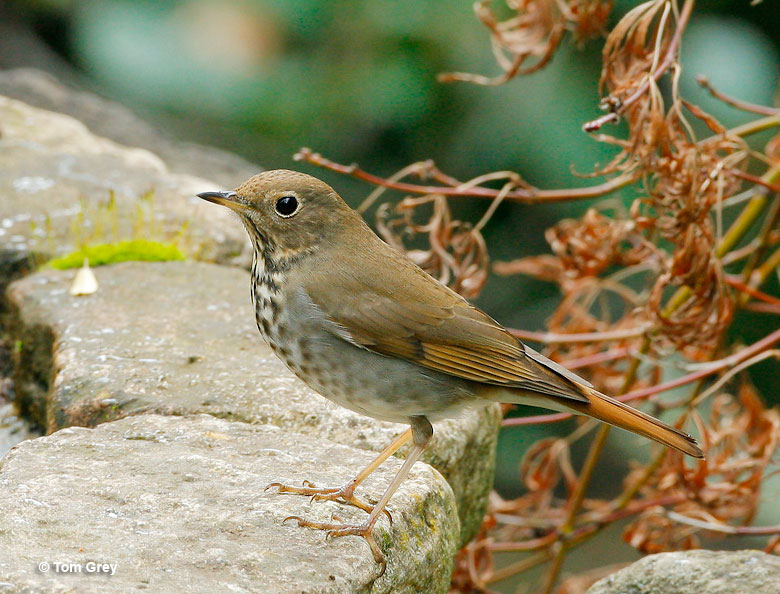The Hermit Thrush (Catharus guttatus) is a small brown bird with dark spots on its chest and a reddish-brown tail.
If you spot a shy brown bird with a red-brown tail beneath shaded vegetation, you may have seen a Hermit Thrush. The lovely song of this common bird is heard in forest habitats throughout its range.
On this page
Identification
The Hermit Thrush is a small thrush around the same size as a bluebird or just a little bit bigger than a junco. They average 6.75 inches in length, have a wingspan of 11.5 inches, and weigh 1.1 ounces.
Both sexes look the same but males tend to be a little bit larger and females have slightly longer bills. However, these differences are only noticeable when measuring birds in the hand.
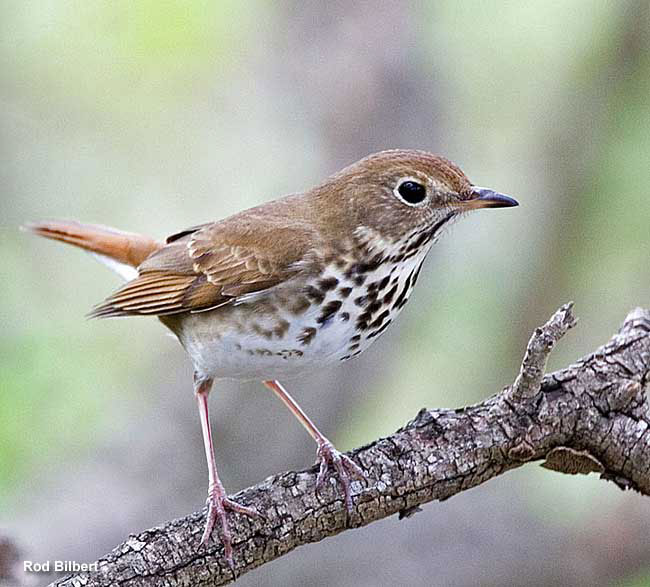
This species is brown above and pale below with dark spotting on its chest and a dark line on each side of its white throat.
The color of the Hermit Thrush’s plumage looks a little bit different depending on where they live.
For example, birds in the east are richer brown above, have more red-brown on their tail, and have some buff on their underparts. Hermit Thrushes in the west tend to be grayer, or have gray flanks.
However, no matter where Hermit Thrushes live, they always have a contrasting red-brown tail, and a pale eyering that is narrower at the front part of its eye.
The male Hermit Thrush’s song is a melodious flute-like phrase that starts with a clear whistled note. Boths sexes also make “chuck” and rising “reeeh” calls.
Food
Hermit Thrushes eat worms, insects, caterpillars, and most other small creatures they manage to catch. They also feed on berries, especially during the fall and winter but prefer bugs, snails, and other invertebrates.
This thrush species forages a lot like an American Robin except that they don’t look for food in open areas. Hermit Thrushes find food on and near the ground underneath vegetation, especially at the edge of woodlands. They also forage in shaded second growth and occur inside forest habitats.
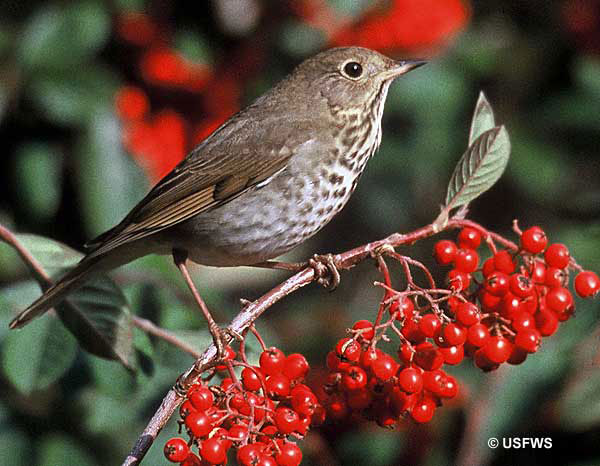
These small birds forage alone and find food by standing on the ground and watching for prey. If they see a bug, they quickly hop over to snatch it with their beak.
They can take prey from the ground, foliage near the ground, or in the lower parts of trees. Hermit Thrushes can also sally into the air or to vegetation to catch insects, but they mostly find bugs on the ground.
Like a lot of other birds that forage on the ground, they may prefer wet spots and areas with dense leaf litter where lots of bugs and other small creatures live.
When Hermit Thrushes feed on berries, they perch in a bush or tree and pick the fruits with their beaks.
Nesting and Eggs
The male Hermit Thrush arrives on its breeding grounds to establish a territory from late March to May. Usually, this “early spring migrant” shows up on breeding grounds before other thrush species arrive.
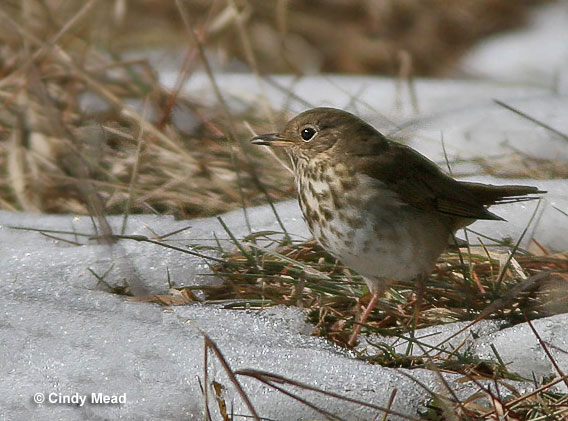
Once the female picks a suitable site, she makes a cup nest out of grass, conifer needles, leaves, and other plant matter mixed with lichen and mud. The female bird lines her nest with soft plant material and builds it underneath or in a short conifer or bush, usually near a road or low, thick vegetation.
Some nests can be 20 feet high, but most are hidden on or near the ground and take around a week to make.
As soon as the nest is done, the female Hermit Thrush lays four blue-gray eggs that are one inch in length and weigh .12 ounces.
She incubates her eggs for 11 to 13 days and during that time is occasionally fed by her mate. He also stays near the nest to give alarm calls and warn the female of potential predators. After the eggs hatch, both parents stay busy feeding the nestlings so they can grow fast and leave 12 days after hatching.
The parents continue to feed the young for a short time after that until they become independent.
Current Situation
The Hermit Thrush breeds in cool forest habitats in Alaska, Canada, the Great lakes region, in the western and northeastern USA, and in parts of the Appalachians.
This small bird winters in woodland habitats around Vancouver south to Baja California, and the southern and eastern USA north to Massachusetts. It also winters in Mexico and northern Central America.
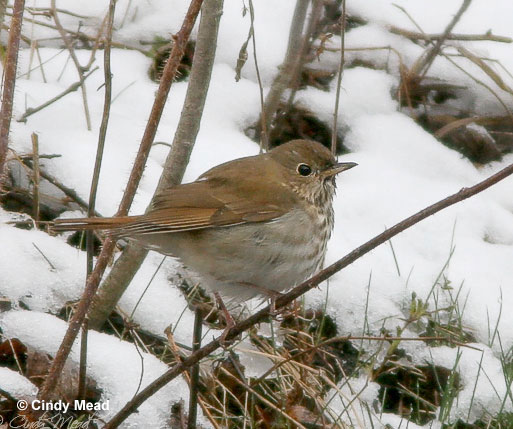
This species is listed as Least Concern in the IUCN Red List. It is a common bird in most of its range and has a large, stable population estimated at 72 million individuals.
Hermit Thrushes are common and doing well but are susceptible to pesticides, extensive logging, and other changes to forest habitats on their breeding and wintering grounds.
Like other small birds that migrate, sadly, many Hermit Thrushes die when they fly into lit windows and towers at night. These and other migrants can be helped by initiatives that turn off lights in buildings at night during migration.
Facts
- Hermit Thrushes sometimes use one of their feet to shake grass and clumps of dead vegetation. They do this to scare insects out of hiding.
- This species starts feeding its young with bits of small, soft bugs but as they grow, both parents give them larger prey items. They can even feed them small salamanders and small snakes!
- Unlike other related thrushes, this hardy species doesn’t migrate to the Amazon or other distant tropical destinations. Although many do migrate to mountains in Mexico, quite a few Hermit Thrushes winter as far north as New Jersey and Vancouver.
- We sometimes find the unobtrusive Hermit Thrush after noticing it move its tail or wings. This species has a tendency to flick its wings and quickly raise and then slowly lower its tail.
- Like several other species, Hermit Thrushes that live in western North America differ in some ways from the Hermit Thrushes that live in eastern North America. In addition to subtle color differences, western birds nest in shrubs and trees, while eastern birds only nest on the ground.
- Hermit Thrush is the state bird of Vermont. It has been symbolizing the state for over 80 years!
Similar Species
The Hermit Thrush looks like a few other, related thrush species. However, it can be separated from them by a few important field marks.
Swainson’s Thrush
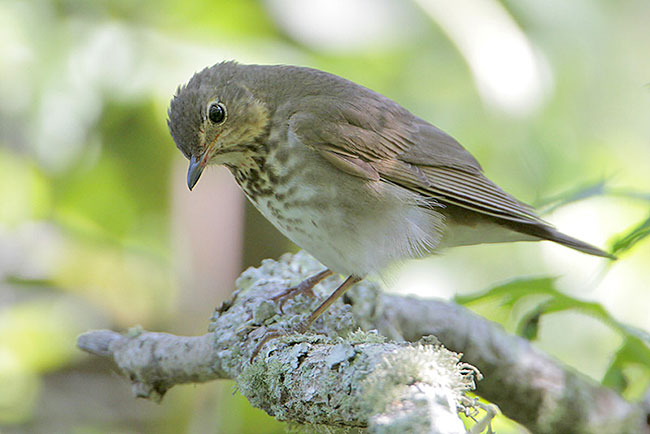
The Swainson’s Thrush also has spots on its underparts but it has a buff eyering, and is buffier on its breast. It can have a red-brown tail but it is never as contrasting red-brown as the Hermit Thrush.
Gray-cheeked Thrush
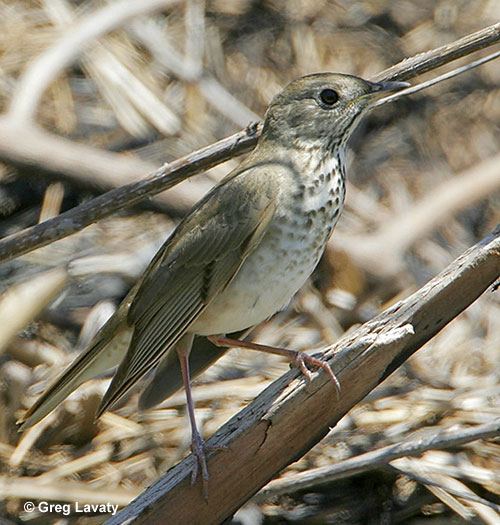
The Gray-cheeked Thrush is usually more heavily spotted below than the Hermit Thrush. It lacks a distinct eyering, has more of a gray face, is not as warm brown, and lacks a red-brown tail.
Veery
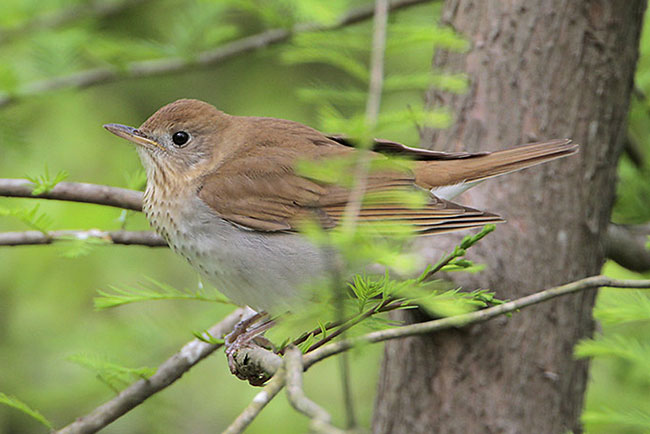
The Veery can be seen in some of the same places as the Hermit Thrush. Veerys can also have an eyering but it is never as obvious as the eyering of the Hermit Thrush. The Veery also has much more red-brown upperparts and does not have black spotting on its chest.
Frequently Asked Questions
Are Hermit Thrushes rare?
No, Hermit Thrushes are not rare. They are common birds throughout their range. However, their reclusive behavior can make them easy to overlook.
Why is the Hermit Thrush called the Hermit Thrush?
The Hermit Thrush is called the Hermit Thrush because it tends to be a shy and reclusive bird. It is also usually found alone in quiet, wooded habitats.
What is the difference between Wood and Hermit Thrush?
The difference between Wood and Hermit Thrush is that the Wood Thrush has a red-brown back, and has more uniform black spotting on white underparts.
Where do Hermit Thrushes live?
Hermit Thrushes live in forest habitats from Alaska and Canada to Mexico. They nest in cool northern and montane forests and winter in a variety of forest and woodland habitats.
Is a Hermit Thrush a songbird?
Yes, a Hermit Thrush is a songbird. Like other songbirds, it is a “Passerine”.

